Report 2-Concepts of Color in Four Asian Countries - Colors associated with Japan

Analysts: Nuangjakchim Roongthumruang, INTAGE Inc. Takashi Inaba, Nippon Color & Design Research Institute Inc.
Overview
- "Red" and "White" are the top two colors associated with Japan not only for the Japanese themselves, but also for respondents from the other three Asian countries. After "Red" and "White," the selections diverged: the Japanese tended to choose bluish colors, while many in the other three Asian countries chose pinkish colors representative of the "cherry blossom."
Analysis
1. What Color Best Represents Japan? : "Results in Japan" vs. "Results in the Other Three Asian Countries"
"Red" and "White" are the top two colors associated with Japan not only for the Japanese themselves, but also for respondents from the other three Asian countries. After "Red" and "White," the selections diverged: the Japanese tended to choose bluish colors, while many in the other three Asian countries chose pinkish colors.
Figure 1 shows the colors thought to best represent Japan’s both by the Japanese and by people in the other three Asian countries (Chinese, Thais, and Vietnamese). "Red" and "White," the colors used in the Japanese national flag (Hinomaru), were the top two selections in both groups. The Japanese, however, selected "Red" much more frequently than "White" (50% vs. 10%), whereas the other three Asian groups selected the two colors at about equal frequency (approx. 30% vs. 30%). People in other Asian countries may associate "White" with the cleanliness of Japanese cities and Japan’s advanced skin-whitening culture.
After "Red" and "White," Japanese tended to choose bluish colors for their country, while Chinese, Thais, and Vietnamese tended to choose pinkish colors. The Japanese may be more familiar with the traditional "Japanese Blue" in indigo dyeing (Aizome) than the other groups. Blue tones, such as "Samurai Blue," are also often used in the uniforms of Japan’s national sports teams. People in the other three Asian countries may associate pinkish colors with the cherry blossom, Japan’s national flower, or with the concept of "KAWAII" in modern Japanese pop culture.
[Figure 1] Colors ranked as most representative of Japan among the Japanese themselves and among respondents in the other three Asian countries (China, Thailand, and Vietnam)
(MA)
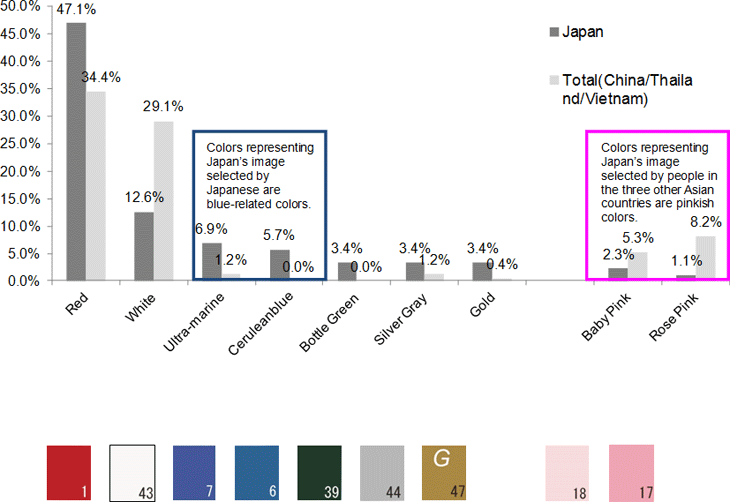
- * The number shown on each color refers to the color sample number.
2. Colors representing Japan: "By Country"
Response trends by country: Chinese respondents selected achromatic colors while Vietnamese chose warm colors (pink, orange, and red purple).
The charts below show the colors selected as the most representative of Japan by respondents in the survey countries. Pinkish colors are commonly perceived as representative of Japan among respondents from Thailand, Vietnam, and China.
Respondents from Japan selected "Red" most frequently, followed by "White," bluish colors, "Bottle Green" (suggestive of nature), urbanized "Light Gray," and "Gold" (symbolizing economic affluence). Chinese, who may regard "Red" as a color for their own country, selected "Red" for Japan less frequently. For this reason, the Chinese respondents chose achromatic colors like "Black," "Light Gray," and "Dark Gray" more often than the respondents Thailand and Vietnam. The Chinese may have strong impressions of Japan as a highly developed country with modernized cities. In contrast, 65.5% of Thai respondents selected "Red" for Japan (more frequently than respondents from the other countries surveyed, including Japan itself). The Vietnamese seem to have more variable images of Japan in terms of color. They sometimes selected "Orange" and "Red Purple," reddish colors not selected in the other countries (colors perceived as "Asiatic colors" in Japan).
[Figure 2] Colors Representing Japan by Country (MA)
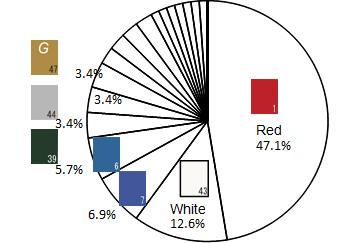
Colors representing Japan according to the Japanese
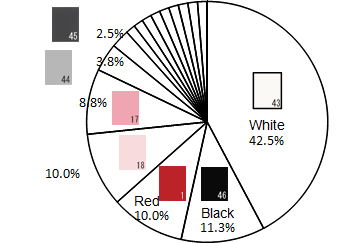
Colors representing Japan according to the Chinese
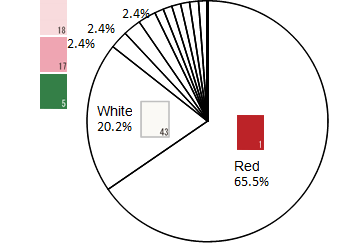
Colors representing Japan according to the Thais
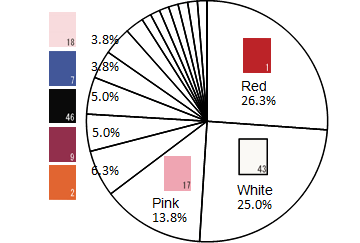
Colors representing Japan according to the Vietnamese
- * Sample numbers from the questionnaire color panel are printed directly over the colors.
Survey Overview
| Survey Method | Self-administered questionnaire survey (with an accompanying panel of color samples) |
|---|---|
| Survey Area | Japan, China, Thailand, and Vietnam |
| Respondents | Males and females, aged 20 to 59 |
| Survey Samples | Japanese (Male 44: Female 43), Chinese (Male 40: Female 40), Thai (Male 42: Female 42) and Vietnamese (Male 40: Female 40) |
| Survey Period | January 2013 to April 2013 |
| Organizations Conducting the Survey | INTAGE Inc. and its overseas subsidiaries |
- * The survey results were analyzed jointly by INTAGE Inc. and Nippon Color & Design Research Institute Inc.
Asia Insight Report
INTAGE Inc. publishes the "Asia Insight Report" based on spontaneous surveys conducted in the Asian region in collaboration with overseas INTAGE subsidiaries to identify trends in attitudes and behavior on various themes.
Part 2 of the Report, "Color Image Survey in Four Asian Countries - What Color Best Represents Japan?" was analyzed jointly with Nippon Color & Design Research Institute Inc. The survey was conducted in Japan, China, Thailand, and Vietnam from January 2013 to April 2013. About 80 males and females (aged from 20 to 59) in each country were asked to fill out a self-administered survey questionnaire using a panel of color samples. The survey results follow below.
Nippon Color & Design Research Institute Inc.
Nippon Color & Design Research Institute Inc. (Head Office: Bunkyo-ku, Tokyo; Date of Establishment: January 20, 1967; President: Naoki Miyaoka) provides information based on psychological research on color designs and consumer tastes to many corporations and organizations in various industries (manufacturing, retail distribution, advertisement, construction, etc.), as well as the public sector. The company’s independently developed "Hue & Tone" system and "Color Image Scale" are widely used in various fields for color planning, marketing, and color design strategies.
